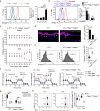Survival of tissue-resident memory T cells requires exogenous lipid uptake and metabolism
- PMID: 28219080
- PMCID: PMC5509051
- DOI: 10.1038/nature21379
Survival of tissue-resident memory T cells requires exogenous lipid uptake and metabolism
Abstract
Tissue-resident memory T (TRM) cells persist indefinitely in epithelial barrier tissues and protect the host against pathogens. However, the biological pathways that enable the long-term survival of TRM cells are obscure. Here we show that mouse CD8+ TRM cells generated by viral infection of the skin differentially express high levels of several molecules that mediate lipid uptake and intracellular transport, including fatty-acid-binding proteins 4 and 5 (FABP4 and FABP5). We further show that T-cell-specific deficiency of Fabp4 and Fabp5 (Fabp4/Fabp5) impairs exogenous free fatty acid (FFA) uptake by CD8+ TRM cells and greatly reduces their long-term survival in vivo, while having no effect on the survival of central memory T (TCM) cells in lymph nodes. In vitro, CD8+ TRM cells, but not CD8+ TCM cells, demonstrated increased mitochondrial oxidative metabolism in the presence of exogenous FFAs; this increase was not seen in Fabp4/Fabp5 double-knockout CD8+ TRM cells. The persistence of CD8+ TRM cells in the skin was strongly diminished by inhibition of mitochondrial FFA β-oxidation in vivo. Moreover, skin CD8+ TRM cells that lacked Fabp4/Fabp5 were less effective at protecting mice from cutaneous viral infection, and lung Fabp4/Fabp5 double-knockout CD8+ TRM cells generated by skin vaccinia virus (VACV) infection were less effective at protecting mice from a lethal pulmonary challenge with VACV. Consistent with the mouse data, increased FABP4 and FABP5 expression and enhanced extracellular FFA uptake were also demonstrated in human CD8+ TRM cells in normal and psoriatic skin. These results suggest that FABP4 and FABP5 have a critical role in the maintenance, longevity and function of CD8+ TRM cells, and suggest that CD8+ TRM cells use exogenous FFAs and their oxidative metabolism to persist in tissue and to mediate protective immunity.
Conflict of interest statement
The authors declare no competing financial interests. Readers are welcome to comment on the online version of the paper.
Figures














Comment in
-
Tissue-resident memory T cells live off the fat of the land.Cell Res. 2017 Jul;27(7):847-848. doi: 10.1038/cr.2017.49. Epub 2017 Mar 31. Cell Res. 2017. PMID: 28361896 Free PMC article.
References
-
- Gebhardt T, et al. Memory T cells in nonlymphoid tissue that provide enhanced local immunity during infection with herpes simplex virus. Nat Immunol. 2009;10:524–530. - PubMed
Publication types
MeSH terms
Substances
Grants and funding
LinkOut - more resources
Full Text Sources
Other Literature Sources
Molecular Biology Databases
Research Materials
Miscellaneous

